It’s the end of another week, which means it’s also time to catch our readers up on stories we didn’t cover last week. As always, last week’s 3D printing news included new industry manufacturing and distribution partnerships; medical, scientific, architectural, and artistic innovations; educational opportunities and initiatives; contests; and new printable applications and products.
Germany’s Ingram Micro to Distribute RepRap 3D Printing Products
We will begin this week’s missed news in Europe, and more specifically Germany, where German Rep Rap has just gotten a big boost from Europe’s largest wholesale  electronics distributor. Germany’s Ingram Micro has announced it will begin to distribute German RepRap open source 3D printing products, including its NEO 3D Printer, scanners, and filament. This deal both widens access to a greater range of 3D printing products and helps boost German RepRap‘s market share, bringing the concept of open source design and manufacturing to a larger 3D printing audience.
electronics distributor. Germany’s Ingram Micro has announced it will begin to distribute German RepRap open source 3D printing products, including its NEO 3D Printer, scanners, and filament. This deal both widens access to a greater range of 3D printing products and helps boost German RepRap‘s market share, bringing the concept of open source design and manufacturing to a larger 3D printing audience.
German Companies Seal Deal for Laser-Printed Components
Beyond distribution to manufacturing news, two German companies, Concept Laser and RSC Engineering, have announced a partnership to produce laser-based 3D printed components that promise more resiliency and faster overall movement time from prototype to product. This new laser-based design concept optimizes the geometries of component parts and eliminates the need for assembly in the cooling and production of parts and the substitution of a milled or cast component. This partnership also promises to keep Germany squarely in the 3D printed components market niche, as laser technology leads the way in the 3D printing of the not so distant future.
Stuttgart 3D Prints “Hygroscopic” Responses for Building Structures
Speaking of the not so distant future, the University of Stuttgart is making 3D structures that practice the art of biomimicry — when artificial structures mimic biological processes found in nature. The idea is, just as plants absorb moisture in the air, thus better adapting to atmospheric changes, so can buildings. Basic 3D printing has allowed the research team to 3D print both actuators and sensors that constitute these adaptive structures that can adjust themselves to humidity and reduce energy consumption. If you are excited about the potential for 3D printing the homes of the future, imagine the 3D printed biomimicry potential along with it.
Poland’s MonkeyFab Unveils 3D Printed National Symbol
Just around the corner from Germany, Polish 3D printing company MonkeyFab unveiled its giant, 5 foot tall, 3D printed Polish national symbol: the White Eagle. Taking a week to print, the bird is made up of 91 different STL files printed using eight 3D printers running nonstop; printing took anywhere from one to ten hours per piece to complete. What better way to solidify a country’s commitment to growing 3D printing technology than to print and display your national symbol?
Amsterdam Museum Inherits Larmann’s 3D Printed Chair
There’s more news from Europe: are you sitting down for this? The Makerchair Hexagon is probably the first open sour ce 3D printable chair anywhere, and now the public can see it on display at Amsterdam’s Riksmuseum since it’s been donated by a private donor. This innovative furniture design is part of Dutch 3D printing designer Joris Larmann‘s “Bits and Parts”series which makes 3D printed full sized furniture accessible, affordable, and stylish by offering multi-piece furniture designs that can be printed on desktop 3D printers.
ce 3D printable chair anywhere, and now the public can see it on display at Amsterdam’s Riksmuseum since it’s been donated by a private donor. This innovative furniture design is part of Dutch 3D printing designer Joris Larmann‘s “Bits and Parts”series which makes 3D printed full sized furniture accessible, affordable, and stylish by offering multi-piece furniture designs that can be printed on desktop 3D printers.
Dutch Designer Seeks to Develop Plastics Recycling Vision
Another Dutch 3D printing designer also made news this week, as Dave Daakens seeks to hand over his original vision, Precious Plastics, to new leadership with a €10,000 job offer. He’s calling for resumes seeking the one to take his already established plastics recycling machine (that uses an injection molder, plastic shredder, an extruder, and a rotational caster) to the next open source plastic recycling mechanical level.
UK’s techfortrade Offers 3D Printing Humanitarian Projects Map
While Germany saw new partnerships in 3D printing distribution, design, and manufacturing, Poland’s MonkeyFab fabricated a symbol of 3D printing’s growing economic role, and the Netherlands reports it has procured a piece of 3D printing design history and continues to pursue 3D printer plastics recycling, the UK’s techfortrade keeps the UK on the map of the international 3D printing scene. It has released a map of international 3D printing charitable efforts to help bridge the divide between emerging technologies, including 3D printing, and international poverty. The techfortrade map summarizes approximately twenty 3D printing projects throughout the world — signifying 3D printing technology’s humanitarian applications in one simple Google map.
UK’s Cybersmile Foundation Uses 3D Printed Ad
Another humanitarian application of 3D printing can be found in the UK’s Cybersmile Foundation‘s anti-cyber bullying ad that uses a 3D printed image. London Graphic Systems (LGS)’ John Robertson teamed up with 3D prosthetic artist Bill Turpin to design the “Words Wound” image — showing computer keys coming up through skin — which is being used by the foundation to make its general message clear. Cyberbullying and hate campaigns will not be tolerated!
Nottingham University Funds Liquid Metal Jetting Doctoral Student
The UK isn’t just known for its 3D printing applications in the nonprofit sector. Other 3D printing news from the UK comes from Nottingham University: home of the Additive Manufacturing and 3D Printing Research Group, one of the most prestigious 3D printing research groups in the world. The group has announced a doctoral scholarship appointment for a student interested in 3D printing using liquid metal jetting. Using multiple metals, liquid metal jetting will expand the 3D printing of smart devices, multi-functional and new electrical conductive components. The scholarship is good news for 3D printing students who want to be on the cutting edge of future design and manufacturing technology.
Millenial Trains Project Announces 2015 Tour Details
Speaking of 3D printing educational initiatives, mobile hackerspaces have received much press for exposing a wide diversity of young people to the future of 3D printing technology. We’ve heard about mobil e hackerspaces, like the trailers Fujitsu sponsored that just toured the Bay Area, but don’t leave out other forms of transportation. The Millenial Trains Project brings a 3D printing hackerspace to the rails, and it has just announced its next 10 day (May 21-31, 2015) tour cities: LA, Austin, San Antonio, New Orleans, Atlanta, and DC. This train is outfitted with Cube3 and CubePro 3D printers, Sense 3D scanners, computers and tablets — you just need to crowdfund an Indiegogo project for $5,000 and the first 20 applicants get a ticket to ride!
e hackerspaces, like the trailers Fujitsu sponsored that just toured the Bay Area, but don’t leave out other forms of transportation. The Millenial Trains Project brings a 3D printing hackerspace to the rails, and it has just announced its next 10 day (May 21-31, 2015) tour cities: LA, Austin, San Antonio, New Orleans, Atlanta, and DC. This train is outfitted with Cube3 and CubePro 3D printers, Sense 3D scanners, computers and tablets — you just need to crowdfund an Indiegogo project for $5,000 and the first 20 applicants get a ticket to ride!
Washington State University Develops Natural 3D Printed Bone Coating
Not all of the 3D printing news we missed has been from Europe this week. Stateside, 3D printed medical applications continue apace with the announcement that the National Institutes of Health supports research for the development of 3D printed bone coating. The NIH is granting Washington State University’s Professor Sumsita Bose and her team a 5 year grant of $1.8 million; the idea is to improve the coating that is currently used for 3D printed titanium knee and hip replacement parts. The current coating is not as biologically compatible as it could be, and the team plans to work with nanomaterials to add magnesium, zinc, calcium, antibiotics, and other medications to better simulate natural bone rigidity and to speed healing time.
3D Printable In-Game Apps and Selfies
While medical researchers seek better bone materials, game companies are seeking better ways to incorporate your characters and YOU — all through 3D printing. FabZat is a system that allows web app and mobile app developers to use 3D printing in their applications and games. Now, you can 3D print your own selfies and game figures using FabZat’s new applications. Minetoys now uses FabZat’s 3D printing capabilities to create Minecraft-based figures in full color sandstone. LeBlox is also offering FabZat compatability to allow us to print a block mini selfie, or ones of friends or favorite celebrities. These services are easy to use and affordable, making the in-gaming application of 3D printing a much more popular past time.
Skip Selfie, Print a Monster?
Depending on your mood or sense of humor, you may want to skip the selfie and just 3D print a new little monster instead. The new MakerBot application, My Little Monster-Make it Real app, is available here.
Autodesk Moves into Federal Government Sector
Since it’s now the holiday season and so close to tax season as well, it would be so unfair to end this review of stories we missed with news about the federal government. Good news: we don’t have to! In more US 3D printing news, 3D printing giant Autodesk has named Carahsoft Technology Corp., a solutions provider for government IT services, as its master government reseller. In layperson’s terms, Autodesk will be positioned to expand its vast 3D printing services further by servicing the federal government in the areas of facilities building and management, weapons systems, games/training, and intelligence.
Domo Can Spark Your Holiday Spirit
It appears we will be seeing much more 3D printing everywhere in 2015 and we will also be seeing more of Domo, the Japanese icon. Cincinnati-based 3DLT has partnered with Big Tent Entertainment to make Domo widely available for designing, selling, and manufacturing products. A downloadable file of the Domo Santa ornament is even available for all your holiday needs — including serving as a distraction from the hard realities of paying holiday bills and, yes, the inevitable tax season. Print away here.
Finally, if you are already thinking ahead to the New Year, then consider for a moment how shedding skin signifies birth and renewal. Then think about 3D printed snake skin. Ohio-based professors/artists have created 3D printed snake skin sleeves that look cool on and leave an imprint when removed. The skin’s creators just won the award at the International Symposium on Wearable Computing’s Design Exhibition for aesthetic design, and it’s not difficult to see why when you check their skins out. These designs go way past fishnet to something looking oddly futuristic and familiar: just like 2015 — which is just around the corner!
Which of these stories did you find the most intriguing? Let us know what you want to hear more about in the Stories We Missed forum thread at 3DPB.com.
Subscribe to Our Email Newsletter
Stay up-to-date on all the latest news from the 3D printing industry and receive information and offers from third party vendors.
You May Also Like
World’s Largest Polymer 3D Printer Unveiled by UMaine: Houses, Tools, Boats to Come
The University of Maine has once again broken its own record by unveiling the largest polymer 3D printer in the world. Surpassing its 2019 achievement, the new Factory of the...
Changing the Landscape: 1Print Co-Founder Adam Friedman on His Unique Approach to 3D Printed Construction
Additive construction (AC) is much more versatile than it seems, at first: as natural as it is to focus on the exciting prospect of automated home construction, there’s far more...
Gorilla Sports GE’s First 3D Printed Titanium Cast
How do you help a gorilla with a broken arm? Sounds like the start of a bad joke a zookeeper might tell, but it’s an actual dilemma recently faced by...
3D Printing Webinar and Event Roundup: April 21, 2024
It’s another busy week of webinars and events, starting with Hannover Messe in Germany and continuing with Metalcasting Congress, Chinaplas, TechBlick’s Innovation Festival, and more. Stratasys continues its advanced training...































